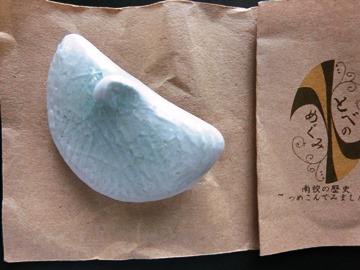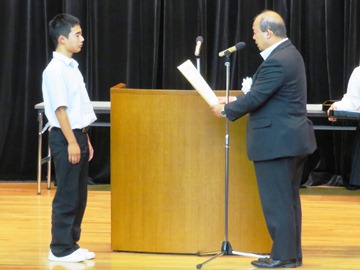Last year, the students of Tobe branch school made a broach using the glaze which Icho (ginkgo in English)-girls made with leaves of ginkgo trees in Matsuyama Minami High School. When they sold the broaches in their school festival, they received a high evaluation! (There is a picture below.)
By the way, this year Ume (plum in English)-chans are going to produce a small dish with the glaze made from branches of Nanaore plums in Tobe Town. The other day, the first trial products were made by Ume-chans. They used small unglazed pots made by students of Tobe branch school. By using ash (burned plums) containing iron, they made a green glaze. When they mixed it with feldspar, its color turns into white. They will continue making pots with this glaze, making improvements of it.
Although the report of Ume-chans has been stopped temporarily, their research is going well. I am planning to report it again. And they want to make not only the glaze that Icho-girls and Ume-chans hope but also the glaze that students of Tobe branch school want to use.
They will try to make fascinating “Tobe-yaki.” They would like to ask continued support. They are going to sell their small dishes in the school festival of Tobe branch high school on Saturday, November 9th. Please look forward to seeing their dishes then. (201HR H.Y.)


Presentation Meeting for Science and Mathematics Course Students of High School in Chugoku, Shikoku, and Kyushu district
Our students participated in Presentation Meeting for Science and Mathematics Course Students of High School in Chugoku, Shikoku, and Kyushu district on Monday, August 19th and Tuesday, 20th. At Yamaguchi Health Promotion Center, 16 stage presentations and 50 poster presentations were given by students of science and mathematics courses in Chugoku, Shikoku, and Kyushu district.
Third graders who belongs to “Vitamin C,” “pollen fossils,” and “mathematics” group gave poster presentations from our school.
On the first day, they gave poster presentations including a judge. Our students did well in the long work of an hour and thirty minutes
On the second day, they were very motivated and raised their hands to ask questions as one of the audience.
The mathematics group won the best prize. Everyone worked hard despite of the tight schedule.
(201HR A.D. , M.T., A.M., N.W.)



